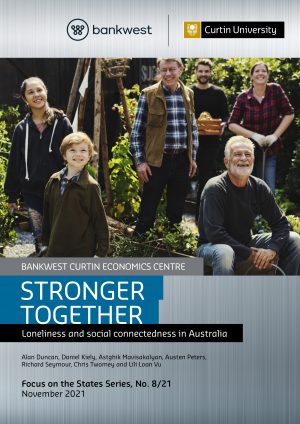Pandemic increases loneliness among Australians with adverse health outcomes costing up to $2.7 billion per year

— Young people, particularly women, hardest hit by loneliness during pandemic —
— More risk-taking behaviours during pandemic due to mental, physical health decline —
— Digital interactions no substitute for face-to-face —
— Public trust in government boosted during pandemic —
Released today by the Bankwest Curtin Economics Centre, the Stronger Together: Loneliness and social connectedness in Australia report has revealed overall social connectivity in Australia, which had been in steady decline for the past decade, decreased dramatically during the pandemic, with associated poor health outcomes costing up to $2.7 billion each year.
The breadth of people’s social experiences through the COVID-19 pandemic in Australia is a special focus of the report with the authors tracking changes in social connectedness, participation and trust before and after the pandemic.
Co-author and Bankwest Curtin Economics Centre Director John Curtin Distinguished Professor Alan Duncan said the report found loneliness was associated with poor physical and mental health outcomes and the adoption of risky health behaviours, which came at a social and economic cost.
“People who become lonely, or remain lonely, visit their GPs more often and present at hospital more frequently. Social isolation is also associated with less physical exercise, a greater prevalence of regular smoking and excessive alcohol consumption,” Professor Duncan said.
“We found the overall costs associated with the prevalence of loneliness in society to be up to $2.7 billion each year, an equivalent annual cost of $1565 for each person who becomes lonely.
“More than half of women and men aged over 65 who feel lonely most of the time report poor health, which is around twice the rate of those who do not feel lonely. Both men and women in the same age cohort who report being lonely pay nearly 10 visits per year to their GP – around four visits more than their not-lonely counterparts.
“Taken all together, these findings indicate that increasing loneliness comes at a high cost to our society and that mitigating loneliness could reduce demands on our health system, improve community connectedness and enhance personal wellbeing through the life course.”
Co-author Associate Professor Astghik Mavisakalyan said young people, particularly women, were hardest hit by loneliness, before and during the pandemic.
“Many young Australians, in particular young women, have found it difficult to adjust to a way of life with long periods of confinement to the home and significantly less face-to-face contact with family and friends,” Associate Professor Mavisakalyan said.
“During the COVID-19 restriction period, over 67 per cent of young women found not being able to see friends or family difficult, compared to half of young men, which led to an increased sense of isolation, with young women twice as likely to feel lonely than young men.
“The amount of emotional support sought by young people during 2020 also increased, with 59 per cent of young women and 41 per cent of young men reporting needing a greater level of emotional support during restrictions.
“Many people reported an increase in the number of social media postings they made during lockdowns, in order to maintain their social connections, with young women doing this more so than young men.
“Pre-COVID 19 data suggests that in the general population, 54 per cent of Australians who had mostly or entirely face-to-face contact with family and friends never felt left out, compared to 41 per cent of those who had most or all of their social contact through the internet.”
The report found that the move towards online service delivery in Australia risks increasing loneliness among vulnerable groups, particularly senior Australians who may not have the resources or confidence to engage effectively with online services.
“Far from bringing people closer together, the move towards online service delivery can actually increase social isolation among service clients. Many people draw comfort and security from meeting face-to-face with service providers, and online should never be regarded as a perfect substitute for personal contact,” Associate Professor Mavisakalyan said.
Among the report’s other findings was that public trust in government and public institutions such as healthcare services and police increased during the pandemic. However, this was not true for Indigenous Australians, who consistently reported much lower levels of trust in institutions as well as the wider community in general.
Key findings
- Social isolation is most prevalent among vulnerable members of society, including people with disability, socio-economically disadvantaged background and culturally and linguistically diverse groups.
- Social connectedness is lower in remote areas compared to major cities and regional areas. However, interpersonal trust is highest in remote areas.
- ACT and WA have the highest social connectedness scores in Australia and rank first and second respectively across all social interactions and interpersonal trust indicators while QLD and SA score lowest on social connectedness.
- Women score higher than men on social connectedness across all ages, but this drops significantly for young men and women between ages 15-17 and 18-24.
- Social interactions and interpersonal trust are poorest among men aged 18-24.
- The social connectedness of people with a disability is around 10 per cent less than that of people with no disability.
- Indigenous people score lower on all dimensions of social connectedness, with an overall index score 39 per cent lower than non-Indigenous Australians. Interpersonal trust of Indigenous people is 64 per cent lower.
- Personal injury and serious illness reduce social support and interpersonal trust.
- Among those aged under 17, 14 per cent of young men and 22 per cent of young women report being very lonely, while among those aged over 65, 17 per cent of men and 21 per cent of women report being very lonely.
- Those in the lowest income decile are more than twice as likely to report being very lonely most of the time, compared to those in the highest income decile.
- People with a disability are more likely to feel lonely than those without a disability and hearing impairment is the strongest driver of loneliness, with 42 per cent of men and 46 per cent of women with this form of disability experiencing loneliness.
- Equal opportunity and employment policy clearly needs to do more to close the gap in employment outcomes for people with a disability, to ensure their knowledge, skills and experience are better recognised and rewarded within the workforce.
- Self-reported likelihood of feeling lonely or very lonely varies by country of origin, with migrants from Central Asia, South Eastern Europe, South America, Central and West Africa and the Middle East much more likely to report loneliness.
- Generally, migrants at greatest risk of feeling lonely in Australia seem to come from countries that are linguistically and culturally different to those who have historically settled in Australia and influenced its culture.
- Young migrant women living in areas where there are less than 5 per thousand from their country of origin are the loneliest, followed by young men aged 20-29.
- Victoria saw the largest decline in face-to-face contact with family or friends outside of the household, dropping from 71 per cent in 2019 to 34 per cent of respondents in 2020.
- The NT and Western Australia saw the smallest decline in face-to-face contact outside the household, dropping 8.7 and 9.7 points respectively across the same period.
- Rates of unpaid voluntary work dropped across all states between 2019 and 2020.
- The drops in voluntary work were largest in Victoria and New South Wales: larger states facing higher rates of community transmission during the survey period.
- The proportion of people stating ‘most people in society can be trusted’ rose from 53 per cent in 2019 to 61 per cent in 2020.
- In 2020, trust in our healthcare system rose 10 points (to 76 per cent), trust in our justice system rose 4 points (to 62 per cent) and trust in the police rose 2 points (to 79 per cent).
- Young Australians, particularly young women found it difficult to adjust to a way of life with significantly less face-to-face contact with family and friends.
- During COVID-19 restriction periods, over 67 per cent of young women found not being able to see friends or family difficult or very difficult, compared to 50 per cent of young men.
- Young women (35 per cent) were much more likely than young men (22 per cent) to post once or twice a week on social media in 2020 outside of the COVID-19 restriction periods.





